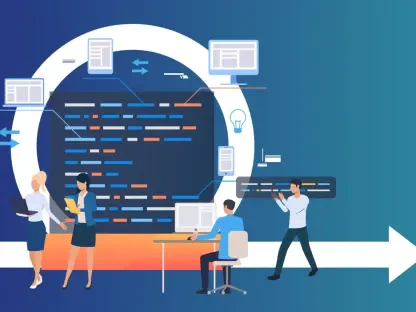Overview of Enterprise Software Development in 2026
The landscape of enterprise software development in 2026 stands as a cornerstone of global business operations, with digital transformation initiatives reshaping how companies operate at scale. As organizations across industries strive to stay competitive, software solutions are pivotal in streamlining processes, enhancing customer experiences, and driving innovation. This dynamic environment sees Fortune 500 companies and smaller enterprises alike investing heavily in technology to meet the demands of an increasingly digital economy, where agility and adaptability are paramount.
Key segments such as cloud-native architectures, artificial intelligence integration, and mission-critical applications dominate the current focus. The adoption of microservices and distributed systems continues to accelerate, enabling businesses to build modular, scalable solutions that can adapt to rapid changes. These technological influences are reshaping software development, pushing for greater efficiency and resilience in handling complex workloads across diverse environments.
Moreover, the growing emphasis on compliance and security is a significant driver in shaping software strategies. With cyber threats on the rise and regulatory frameworks tightening, enterprises must prioritize robust systems that safeguard sensitive data. Major market players are aligning their development efforts with stringent standards, ensuring that their software not only meets operational needs but also adheres to legal and ethical guidelines in highly regulated sectors like finance and healthcare.
Key Programming Languages Shaping Enterprise Software
Dominant Languages and Their Enterprise Use Cases
In the realm of enterprise software, certain programming languages stand out for their proven reliability and adaptability to complex needs. Java remains a bedrock for many large-scale applications, particularly in banking and telecom, due to its scalability, stability, and extensive ecosystem of frameworks like Spring Boot. Its ability to run on the Java Virtual Machine ensures portability across diverse platforms, making it a preferred choice for mission-critical systems.
Python has surged in prominence, especially for its role in AI and automation within enterprise settings. Its vast library support for machine learning and data analytics empowers businesses to derive actionable insights from massive datasets, while JavaScript, bolstered by TypeScript’s type safety, continues to lead in crafting interactive web interfaces for SaaS platforms. These languages collectively address a wide spectrum of needs, from backend logic to user-facing applications.
Emerging contenders like Rust and Go, alongside niche players such as Kotlin, Swift, PHP, and SQL, are carving out specialized roles. Rust tackles security challenges with memory safety features, Go excels in cloud-native microservices, and polyglot architectures are increasingly common, allowing enterprises to leverage multiple languages to meet varied requirements. This trend reflects a strategic approach to balancing innovation with operational demands.
Market Insights and Adoption Trends
Data underscores the enduring dominance of established languages, with Java powering over 90% of Fortune 500 companies’ systems due to its robust performance in high-stakes environments. Python has seen a 40% rise in enterprise adoption for AI-driven projects, highlighting its critical role in modern analytics workflows. These figures point to a sustained reliance on proven tools for core business functions.
Looking at growth trajectories, Go is experiencing a 30% year-over-year increase in cloud project implementations, driven by its efficiency in distributed systems like Kubernetes. Rust, meanwhile, boasts high developer satisfaction rates, positioning it as a future leader for secure application development. Such trends suggest a shift toward languages that prioritize performance and safety in response to evolving technical challenges.
Projections through 2026 indicate that these adoption patterns will significantly influence enterprise strategies. Businesses are expected to integrate a mix of languages to optimize for specific use cases, with cloud compatibility and security features becoming decisive factors. This forward-looking approach will likely redefine how organizations allocate resources and build their technology stacks to maintain a competitive edge.
Challenges in Programming Language Adoption for Enterprises
Navigating the adoption of programming languages in enterprise environments presents a range of technical hurdles. Newer languages like Rust often come with a steep learning curve, requiring significant investment in developer training to harness their full potential. Meanwhile, versatile languages such as Python can face scalability limitations when deployed in high-volume, performance-intensive scenarios, posing risks to operational efficiency.
Market-driven challenges further complicate the landscape, particularly in balancing the maintenance of legacy systems with modernization goals. Many enterprises still rely on PHP-based platforms for web applications, and transitioning away from such entrenched systems demands careful planning to avoid disruptions. This tension between preserving stability and embracing innovation remains a persistent obstacle for decision-makers.
Potential solutions lie in leveraging frameworks that address inherent language limitations and investing in comprehensive training programs to upskill teams. Adopting standardized tools can ease integration challenges, while fostering a culture of continuous learning helps bridge skill gaps. These strategies enable enterprises to mitigate risks and capitalize on the benefits of diverse programming languages without compromising on existing infrastructure.
Regulatory and Compliance Factors Impacting Language Choice
Security and regulatory compliance play a central role in determining language selection for enterprise software, especially in industries like fintech, healthcare, and banking. These sectors face strict mandates around data protection, necessitating languages with built-in mechanisms to prevent vulnerabilities. Java, with its mature security features, and Rust, with its focus on memory safety, align well with such rigorous standards.
Evolving regulations, including those related to data privacy and cybersecurity, further influence technology stack decisions. Enterprises must ensure that their chosen languages and associated tools facilitate adherence to global frameworks, as non-compliance can result in severe penalties and reputational damage. This dynamic underscores the need for proactive alignment between technical choices and legal requirements.
Integrating compliance into the software development lifecycle is no longer optional but a strategic imperative. Languages that offer robust support for secure coding practices and seamless updates are increasingly favored, as they reduce the burden of meeting regulatory demands. This intersection of technology and policy will continue to shape how enterprises architect their systems in response to an ever-changing landscape.
Future Outlook for Programming Languages in Enterprise Software
As enterprise software development evolves, emerging technologies like AI, cloud-native systems, and the Internet of Things are set to redefine priorities through 2026. These advancements demand languages that can support intelligent automation, seamless scalability, and interconnected ecosystems. Python’s dominance in AI and Go’s strength in distributed environments position them as critical players in this transformation.
Potential disruptors, such as Rust’s growing adoption for secure applications, signal a shift toward prioritizing safety without sacrificing performance. Similarly, Go’s lightweight architecture makes it ideal for microservices in cloud-heavy setups, potentially accelerating its uptake in sectors focused on agility. These developments hint at a future where niche languages gain broader relevance by addressing specific pain points.
Global economic conditions, developer productivity, and the pace of innovation will also influence language preferences. Enterprises are likely to favor tools that enhance efficiency and reduce time-to-market, while economic constraints may drive cost-effective solutions. This confluence of factors suggests a dynamic trajectory for enterprise software, with adaptability and strategic foresight becoming key to navigating upcoming shifts.
Conclusion and Strategic Recommendations
Reflecting on the insights gathered, it becomes evident that a blend of dominant and emerging programming languages shapes the enterprise software landscape leading into 2026. The analysis highlights the critical roles of Java, Python, and JavaScript in maintaining operational stability, while Rust and Go emerge as vital for addressing modern security and cloud demands. This diverse ecosystem underscores the complexity of aligning technology with business imperatives.
Moving forward, enterprises should consider adopting polyglot architectures to harmonize legacy systems with cutting-edge innovation. Investing in targeted training to master newer languages and leveraging frameworks to overcome scalability issues prove to be actionable steps taken by forward-thinking organizations. These measures ensure flexibility in meeting diverse operational needs without disrupting existing workflows.
Ultimately, aligning language choices with long-term scalability, security, and competitive goals emerges as a cornerstone of strategic planning. Businesses that prioritize a balanced technology stack and stay attuned to regulatory shifts position themselves to thrive in a digital economy. Embracing adaptability as a core principle offers a pathway to not only meet current challenges but also anticipate future opportunities in an ever-evolving market.









